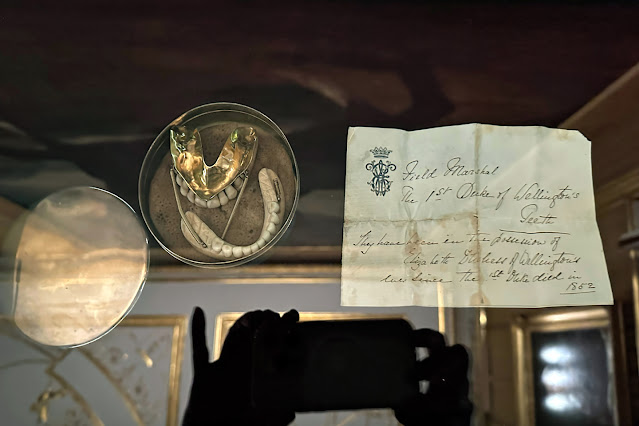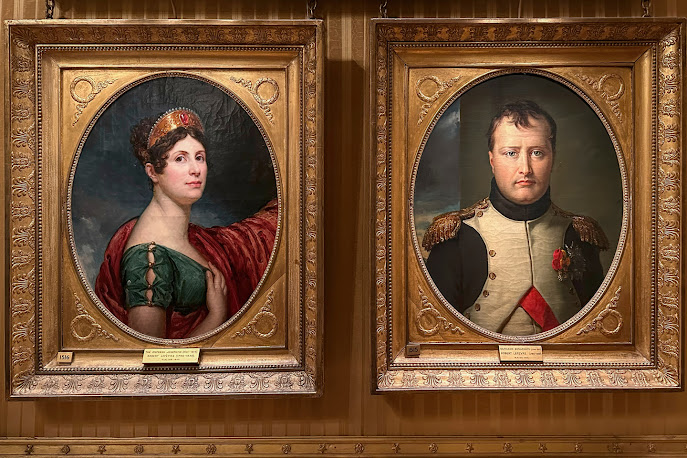travelswithkathleen
I am a native in this world And think in it as a native thinks
Tuesday, July 22, 2025
The Heel Stone
This sarsen stone stands a few hundred feet from the stone circle, outside the earthworks, on what would have been the avenue approaching the monument.
It's placed to align with the sunrise at the midsummer solstice, and the sunset at the winter solstice. You can get tickets to go inside the monument to watch the sunrise and sunset during the hours when the monument isn't open to the public, not just at the solstices.
Labels:
England,
fields,
Stonehenge,
stones,
UNESCO World Heritage
Monday, July 21, 2025
The amazing lintels
If you zoom in on this picture, you can just see where the separate lintel stones are joined together.
Labels:
England,
Stonehenge,
stones,
UNESCO World Heritage
Some useful models
These models in the Visitor Center are really useful for understanding what Stonehenge looked like in 2500 BC and what it looks like today. It consisted of trilithons—two standing stones topped with a lintel—in a rough horseshoe shape, surrounded by a ring of smaller bluestones. The sarsen stones (sarsen is a kind of sandstone common in southern England) in the outer circle are each about thirteen feet high and seven feet wide. Most incredibly, the lintels on top of those stones were connected with mortise and tenon joints. How did they do that?
In the model on the left you can really see the ditch and banks surrounding the site, which were built hundreds of years before the stones were put in place, and are quite impressive on their own—we climbed the bank to see the view on our way to the stones. The “henge” in Stonehenge probably originally meant to hang, but is now used by archaeologists to refer to any circular ditch and bank. We saw another one at Avebury later that day.
In the model on the left you can really see the ditch and banks surrounding the site, which were built hundreds of years before the stones were put in place, and are quite impressive on their own—we climbed the bank to see the view on our way to the stones. The “henge” in Stonehenge probably originally meant to hang, but is now used by archaeologists to refer to any circular ditch and bank. We saw another one at Avebury later that day.
Labels:
England,
models,
Stonehenge,
UNESCO World Heritage
Salisbury Plain
It's a little over a mile from the visitor center to the stones. There's a shuttle bus, but I opted to walk across the fields with the archaeologist who was leading the group. The land is so flat the Dakotas would be envious, and we didn't pass that many people on the path—unlike at the monument, which was of course very crowded. Lots of sheep though.
It was fun to imagine how the people approaching Stonehenge thousands of years ago would have seen a landscape not that different from the one we were walking through, and how amazing that first glimpse of the stones in the distance must have seemed to them. I mean, I knew it was coming and it was still a thrill.
It was fun to imagine how the people approaching Stonehenge thousands of years ago would have seen a landscape not that different from the one we were walking through, and how amazing that first glimpse of the stones in the distance must have seemed to them. I mean, I knew it was coming and it was still a thrill.
Labels:
England,
fields,
grass,
landscapes,
sheep,
Stonehenge,
UNESCO World Heritage
Sunday, July 20, 2025
Approaching Stonehenge
I have wanted to visit Stonehenge ever since I took some astronomy classes in college. It may or may not have functioned as a prehistoric observatory, or as a religious site, or as a place of healing—or, all of the above—but it had such a fascination for me. For years, at every solstice, I'd think, “I wish I were at Stonehenge.”
And when I caught this first glimpse of the stones through the bus window, I couldn't breathe for a moment. There's such a thrill in seeing a place you've seen pictures of all your life: the pyramids, Mont St-Michel, Machu Picchu, even the White House. Oh my God, there it is! I'm really here!
Labels:
England,
ruins,
Stonehenge,
tourist attractions,
UNESCO World Heritage
Bonus bird blogging
There will be no problem identifying this bird: it is most definitely a magpie, looking forward to enjoying the delicious insect it just caught.
Taken by Christ Church Meadow earlier this week.
Sunday bird blogging
Those are starlings sitting on top of the stones, in case you can't tell from the picture, and you probably can't.
But I don't imagine I will ever get to post a picture of birds at Stonehenge again, so tiny starlings it is.
Labels:
bird blogging,
birds,
England,
ruins,
Stonehenge,
UNESCO World Heritage
Saturday, July 19, 2025
The darker side of fame
One of the things I wondered about at Apsley House was how Wellington had coped with his fame, which was relatively sudden and must often have felt overwhelming. At least he didn't know that his false teeth would be displayed to the world after his death.
The original wellingtons
Yes, the boots were named after the duke.
I couldn't get a good picture of them, but I thought it was interesting so I'm including it anyway. The boots generally worn by cavalry were thigh-high and protected the legs during battles, but were difficult to walk in. And the boots worn by infantry were ankle-high, good for walking but not great for keeping the feet dry. So Wellington had waterproof knee-high boots made for himself and they became very popular. They've been made of rubber rather than leather since the mid-nineteenth century, but they're still called wellingtons.
Napoleon and Josephine
The art collection in the museum is really impressive—there are paintings by Velazquez, Titan, Goya, Rubens—and more interesting than all the gilt and mirrors and Adam ceilings in the house itself. But this also includes dozens of paintings and statues of Napoleon (including a colossal statue in the front entryway.) Apparently anyone who owned a painting of the former emperor foisted it off on the duke as a show of admiration.
I do really like these portraits of Napoleon and Josephine, though.
Subscribe to:
Posts (Atom)
Blog Archive
-
▼
2025
(230)
-
▼
July
(57)
- The Heel Stone
- More Stonehenge
- The amazing lintels
- Some useful models
- Salisbury Plain
- Approaching Stonehenge
- Bonus bird blogging
- Sunday bird blogging
- Oh, and I also went here today
- The darker side of fame
- The original wellingtons
- Napoleon and Josephine
- Saturday reflections
- Little house on the prairie
- More canola fields
- Canola
- Windbreak
- Jumping back to, say, North Dakota
- One more dinosaur
- T. Rex
- Ceiling details
- Museum of Natural History
- Sunday bird blogging
- Saturday reflections
- More closeups
- Crazy Horse Memorial
- Avenue of Flags
- I know just how they feel
- I'd rather pretend I'm here
- Badlands redux
- Some unexpected color
- It really is strange...
- Devil's Tower
- More mountain Xanax
- Deep breaths
- More bighorns, plus a baby
- More Glacier fauna
- A Møøse once bit my sister...
- And now for something completely different
- Lovely Spam! Wonderful Spam!
- Meaty Juicy Satisfaction
- Sunday bird blogging
- What Would Jesus Eat?
- The Ice Cream Capitol of the World
- Breakfast of Champions
- Crops
- Hawkeye Point
- Saturday reflections
- Recreation in Hell
- More badlands
- Landscape contrasts
- I don’t give a damn for the same old played out sc...
- Oh, and I also went here today
- Where the deer and the antelope play
- Custer State Park
- Cathedral Spires
- Unknown soldier memorial
-
▼
July
(57)














